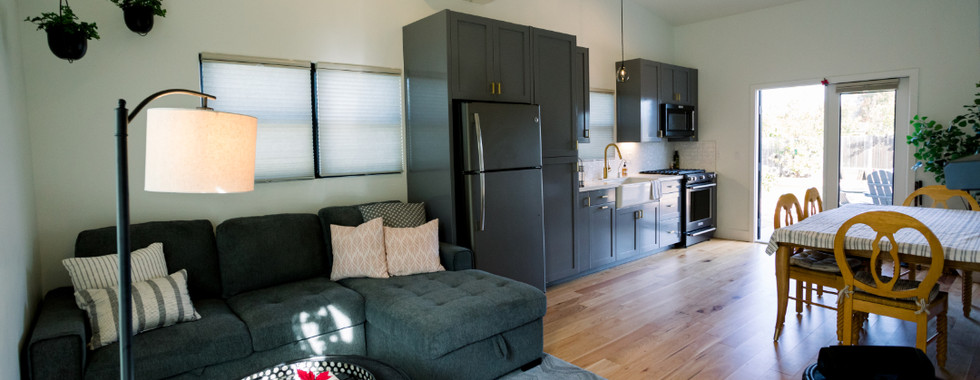Building an ADU in San Luis Obispo County
- Ed Cuming

- Feb 15, 2022
- 4 min read
Updated: Feb 16, 2022
What is an ADU?
ADU stands for accessory dwelling unit. These types of structures are known by many names: granny units, in-law apartments, backyard cottages, secondary suites, casitas, and more. Whatever you call them, ADUs offer many benefits to homeowners and renters alike.
In January 2020, the State of California made it the law that all residential zoning districts (which include single-family and multi-family homes) can build ADUs.
Whether you’re building in the City of San Luis Obispo, Pismo Beach, or elsewhere in San Luis Obispo County, you can add one or more ADUs to your residential property and expect an expedited plan review and approval process.
An ADU has independent living facilities for one or more people, with a few variations:
Attached: Unit is attached to the primary structure.
Detached: Unit is separate from the primary structure (lots of options here like a new structure, a tiny house, or a house on wheels).
Converted Existing Space: Space (e.g. bedroom, garage, or accessory structure) is converted to an independent unit.
Junior Accessory Dwelling Unit (JADU): A specific type of conversion of existing space that is contained entirely within the single-family residence.
See the California Department of Housing and Community Development ADU Handbook for more helpful information.
Benefits of ADUs
Affordability. ADUs do not require you to buy new land, build new major infrastructure, and in many cases no additional parking is required. They are affordable housing options for homeowners, landlords, and renters.
Rental income. The rental price of your ADU will vary depending on location, size, and amenities. According to some estimates, average rent in the City of SLO is $2,222. Visit this site to search average rental prices in your city.
Increased property value. A ballpark estimate is your property value will increase by 100 times the monthly rent of your ADU. For example, if you can rent your ADU at $1,000/month, your property value will increase around $100,000.
Nearby housing for extended family, friends, and caretakers. You may want to maintain your privacy at the same time that you house adult children, retired parents, or people who help with child or elder care. Or you want a space for guests and visitors.
Opportunity to downsize. Perhaps your home is now bigger than what you need. You could downsize into an ADU right in your own backyard, and open up your home to a young family in your community at the same time. Win-win.
ADU Regulations in SLO County
Differences by municipality. Depending on the city or region that your property is in, there are different regulations and requirements for your ADU. For example, SLO County ADU specifications are different if your property falls into either the Coastal or Inland land-use designations. Follow these links to find ADU information specific to SLO County, Pismo Beach, and City of SLO (ordinances are currently being updated for SLO).
Allowed properties. You can have an ADU on your property if residential uses are allowed, although exceptions may apply. You must have an existing or proposed single-family home or multi-family dwelling (e.g. duplex, apartment, or condo).
Allowed number of ADUs. With a single-family home, you can add at least one or possibly two ADUs. The number allowed on multi-family properties depends on the type of ADU you want to build and the number of units already on the property.
Square footage. The maximum ADU size depends on the type and number of ADUs you’re building and varies between 500 and 1,200 sq. ft.
Parking. Requirements for ADU parking are generally minimal, since a city can only require one parking space per ADU or bedroom, whichever is less, and spaces can be one in front of the other in a driveway. Requirements vary from city to city, so check the ADU regulations specific to your property.
Height limits. In general, your ADU can be at least one story or 16 feet in total height.
Setbacks. ADUs must be “set back” or built a minimum distance from your property lines. Again, requirements vary, so check with your municipality for specific requirements.
FAQ
How much does an ADU cost?
The cost of an ADU depends on many factors including the size, design, and cost of labor and materials. In SLO County, you can expect to spend between $120,000 and $300,000 to build an ADU. If you rent it out, it will pay for itself and start making you money back within 7-10 years (not to mention the increase to the value of your property)!
Can I get help paying for the cost of my ADU?
Yes! There are many state and local government grants available to homeowners interested in building ADUs. Find a list of funding opportunities as well as additional information about ADUs here: California Department of Housing and Community Development website
How long does it take to build an ADU?
In 2022, SLO County made changes to the ADU permitting process. It now takes around 60 days to permit an ADU. After that, the time it takes to plan and construct your ADU will vary depending on factors like the design, weather, and the experience of your architect or builder.
Does Ed Cuming Custom Homes build ADUs?
Yes, Ed and his team have extensive experience building ADUs of all types. We can help you navigate all phases of the design, permitting, and building process from start to finish with a focus on achieving the highest quality standards, staying on schedule, and sticking to your budget. Click here to see some of the ADUs we have built here in SLO County.




























Helpful info, thanks!